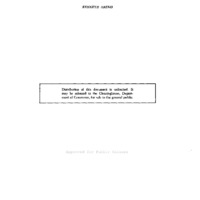-
Title
-
Compound Decision Procedures for Pattern Classification
-
Date
-
1967
-
Index Abstract
-
Not Available
-
Photo Quality
-
Not Needed
-
Report Number
-
AMRL TR 67-10
-
Creator
-
Abend, Kenneth
-
Corporate Author
-
Philco-Ford Corporation
-
Laboratory
-
Biomedical Laboratory
-
Extent
-
107
-
Identifier
-
AD0667570
-
Access Rights
-
Distribution of this document is unlimited. It may be released to the Clearinghouse, Department of Commerce, for sale to the general public.
-
Distribution Classification
-
1
-
Contract
-
AF 33(615)-2966
-
DoD Project
-
7233 - Biological Information Handling Systems and Their Functional Analogs
-
DoD Task
-
723305 - Theory of Information Handling
-
DTIC Record Exists
-
No
-
Distribution Change Authority Correspondence
-
None
-
Distribution Conflict
-
No
-
Abstract
-
Compound decision theory is shown to be powerful as a general theoretical framework for pattern recognition, leading to nonparametric methods, methods of threshold adjustment, and methods for taking context into account. The finite-sample-size performance of the Fix-Hodges nearest-neighbor nonparametric classification procedure is derived for independent binary patterns. The optimum (Bayes) sequential compound decision procedure, for known distributions and dependent states of nature is derived. When the states of nature form a Markov chain, the procedure is recursive, easily implemented, and immediately applicable to the use of context. A similar procedure, in which a decision depends on previous observations only through the decision about the preceding state of nature, can (when the populations are not well separated) yield results significantly worse than a procedure that does not depend on previous observations at all. When the populations are well separated, however, an improvement almost equal to that of the optimum sequential rule is achieved.
-
Report Availability
-
Full text available
-
Date Issued
-
1967-12
-
Provenance
-
RAF Centre of Aviation Medicine
-
Type
-
report
-
Format
-
1 online resource
 AMRLTR67-010.pdf
AMRLTR67-010.pdf